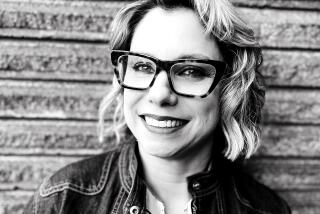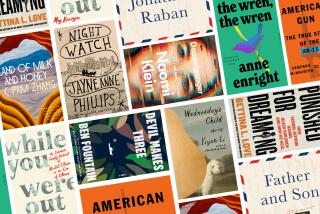The ‘Far Out’ Utne Reader Digests Alternative Press
- Share via
For years, Eric Utne has been a magazine junkie. And like many people, the 40-year-old Minneapolis resident enjoyed sharing his obsession with friends. For Utne, that meant photocopying articles--lots of them. But his friends, he noticed, often thanked him politely, then put aside the articles.
His photocopying bills on the rise, Utne--who already had helped start one magazine (the Boston-based New Age Journal in 1974)--decided to start a second. This one, called the Utne Reader, would summarize articles from other publications. Since his reading preferences tended toward the unusual, the name was appropriate: utne, translated from Norwegian, means “far out.”
In part, Utne says he was motivated by frustration: There was too much to read. “The intent was to reduce people’s reading, rather than expanding it. I didn’t want to add just one more thing to the pile of unread material. I wanted to bring people what I thought was the best that was out there.”
Subtitled “The best of the alternative press,” the first issue of the Utne Reader, a simply designed, 12-page newsletter, appeared in February, 1984.
While putting together that issue, Utne remembered the friends for whom he’d photocopied articles. “I thought, ‘I’m going to get those people to pay for the articles,’ ” he recalled in a telephone interview. “ ‘Then they can do whatever they want with it.’ But I still really wanted them to read it.”
Utne’s vision sounds a lot like a 65-year-old institution in American publishing--Reader’s Digest. Utne read everything he could find about the Digest and also studied other models, notably I. F. Stone’s Weekly and Poor Richard’s Almanack.
He quickly discovered that readers wanted more than summaries, and the Utne Reader expanded to its current book-size, 128-page format. Its cost, however, remains unchanged--$4 an issue or $18 a year for six. Each issue now contains a cover story (excerpts of several articles on a theme), an eclectic selection of material and summaries of recently published articles and books.
Unlike Reader’s Digest, which distills its conservative and nostalgic vision from America’s most popular books and magazines, the Utne Reader leans toward the small and the obscure. The October/November issue of the bimonthly publication, for example, excerpts material from such publications as the North Country Anvil, an ecological quarterly published in Minnesota; the Who Owes Whom Newsletter, a Santa Cruz-based quarterly about the world debt crisis; the Milkweed Chronicle, a literary magazine, and the Journal of Political and Military Sociology, an academic journal published by Northern Illinois University.
In a time when magazines increasingly aim for a narrow, well-defined audience, the Utne Reader revels in an eclecticism that borders on eccentricity. Thus, the current issue juxtaposes articles about witches and “feminist spirituality” with others about Third World debt and the Democratic Party. Its articles--about the farm crisis, for example--often reflect the staff’s Midwestern roots.
The Utne Reader’s circulation is small but growing--about 40,000, up 43% from a year ago. With a major direct-mail subscription campaign planned, Utne hopes to reach 70,000 by the end of the year.
Knowing Writer’s Biases
Utne is an unabashed fan of what he calls “advocacy journalism”--writing with a point of view and often about political and social issues. “I want to know what the writer’s biases are,” he says. “When the writer is forthcoming about his or her biases, I find it easier to assess what the truth is--as long as the reader knows that it’s advocacy journalism, and there’s a clear understanding that what is being presented as truth is mediated by the author’s opinion or bias.”
Asked to name some of his favorite magazines, Utne mentions Bulldozer, subtitled “the only vehicle for prison reform”; Processed World, an angry, anarchistic magazine published by “dissident office workers” who call it the “magazine with a bad attitude,” and New Outlook, a Middle Eastern publication produced jointly by Arabs and Jews.
Much of the reader’s material comes from small but established magazines such as Mother Jones and from news weeklies like the Village Voice. The most frequently used local publication is the L.A. Weekly.
Many editors welcome the national exposure the Utne Reader affords. “They’re good for us,” says Alan Kay, executive editor of the San Francisco Bay Guardian, a news weekly used frequently by the Utne Reader. “They make it known that there is an alternative press in this country, a press that is active and vital. In many cases, we are doing important, cutting-edge journalism, but we are not visible because our focus is so intensely local. It’s nice to get national exposure.”
Before assembling each issue, the seven-member Utne Reader staff must plow through about 1,500 publications. Assisting them in this task are members of the Alternative Press Reading and Dining Salon, volunteers who meet every two months over a vegetarian dinner to discuss (and argue about) their reading. “This,” Utne says, “is the most stimulating part of producing the magazine.”
Despite the reader’s subtitle (“The best of the alternative press”), Utne is reluctant to define the term. “We often have a hard time seeing that label on the magazine, because it doesn’t really suggest what we are,” he says. “We avoid defining it. Alternative is what we find interesting and valuable.
Other Dimensions Provided
“There seems to be a conventional point of view; then there are perspectives which enlarge that point of view--put it in context, either by opposing it, or by providing other dimensions to the story on the evening news and in daily newspapers. Most of that comes from publications that don’t have a very large circulation.”
Still, the Reader occasionally excerpts articles from publications with large circulations like Esquire or the Los Angeles Times.
Although the Utne Reader’s interpretation of “alternative” causes it clearly to lean leftward, the magazine often pairs dramatically different viewpoints. In the current cover selection, “Between Idealism & Cynicism” (“Has a generation turned on, tuned in, and . . . given up?”), is an excerpt of a speech by David Horowitz, an ex-radical and now an outspoken arch-conservative. Horowitz is savagely critical of his “former comrades and successors on the Left” (including, presumably, many subscribers to the Utne Reader).
“My personal objective is to make it as difficult as possible for our readers to put us in any particular niche,” Eric Utne says. He once described the magazine’s politics as being “neither left nor right, but possibly in front.”
Executive Editor Jay Walljasper, 31, compares the alternative press to the Distant Early Warning System, a line of radar stations that provide advance warning of aircraft approaching North America. Walljasper calls the alternative press “America’s D.E.W. Line for social change--detecting important ideas and issues long before they hit the establishment media.”
As an example, Walljasper cites a recent front-page article in the New York Times about “new collar” workers--people born after World War II who are working in service jobs and earning relatively modest incomes. According to some experts, the Times reported, new-collar voters may provide a “key to the future of American politics,” although they are “a hard group to pin down politically.”
New-Collar Cousins
It is a matter of pride to Walljasper that the Utne Reader first wrote about the phenomenon of new-collar workers--demographically, a kind of poor cousin to the yuppie--more than six months before it hit the front-page of the Times.
Probably the best description of the Utne Reader comes from Walljasper, who was actually describing his readers: “They come from two philosophical traditions--in short, leftists and New Agers. Many have the same impulse: Things aren’t exactly right, and they ask, ‘What can we do to change them?’ New Agers have a tendency to take the inward, more spiritual route, whereas leftists and liberals take more of a political/sociological look.
“(In the Utne Reader), someone who meditates and eats whole grains can read about El Salvador. On the other hand, someone who has a conservative view of homeopathic medicine might take a second look based upon something they see in the reader.”
More to Read
Sign up for our Book Club newsletter
Get the latest news, events and more from the Los Angeles Times Book Club, and help us get L.A. reading and talking.
You may occasionally receive promotional content from the Los Angeles Times.









